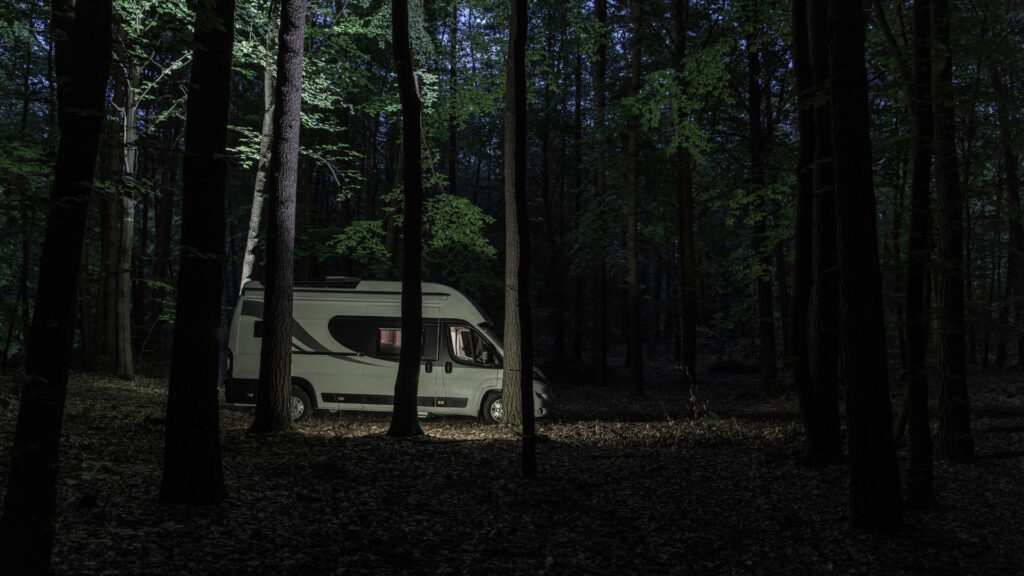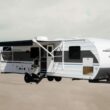Table of Contents Show
You may be an RVer who hits the road first thing in the morning to avoid traffic and have plenty of time to reach your destination. Or you may not head out until lunchtime. Regardless of your travel day routine, there’ll be a time you end up driving your RV at night.
Although we hope this is rare, challenges happen on the road. So today, we’re looking at five tips to keep you safe when driving an RV at night. Let’s dive in!
Is Driving an RV Safe?
The first time driving a motorhome or towing a trailer can be nerve-wracking for some people.
If you’re nervous about driving an RV, consider taking it to a large parking lot where you can learn how to back up and when to start turning the steering wheel. Practice will make you feel much more confident when you hit the road.
But, in general, driving an RV isn’t dangerous. By following defensive driving techniques and staying alert, you’ll arrive safe and sound for a weekend camping trip. There is a learning curve, especially for folks who have never driven anything larger than a Toyota Camry.
But you shouldn’t fear driving an RV or worry about its dangers. Just be a responsible driver to ensure your safety and the safety of others.
Is Driving an RV at Night Safe?
Any type of nighttime driving is less safe than daytime driving. No matter what kind of vehicle you’re taking down the highway, it’s hard to see. The low light makes it harder to see potholes, pedestrians, and wildlife. You may also have glares from oncoming traffic and street signs.
Our reaction time is also slower because we can’t see as well at night. We’re at a greater risk of hitting a car that slams on its brakes in front of us or a deer that jumps out of a roadside thicket.
Driving an RV at night (or any other vehicle) can also lead to eye fatigue. No matter how rested we feel when we start our journey, our eyes get tired as the sun goes down and night grows darker. The constant strain of driving at night can also leave us exhausted.
What’s the 3/3/3 Rule of RVing?
Because of the increased dangers of driving an RV at night, many travelers follow the 3/3/3 Rule of RVing. This guideline limits your drive time, so you arrive at your destination with plenty of daylight left.
Although some RVers modify this rule, the gist is to drive no more than three hours at a time, 300 miles in one day, and arrive at the campground no later than 3 p.m. Some RVers also choose to stay at least three days in one location.
By adhering to the 3/3/3 Rule of RVing, travelers avoid driving their RV at night and having to set up in an unfamiliar location in the dark. Although this isn’t always possible, it’s a great guideline, especially for RVers new to camping.
5 Tips for Driving an RV at Night
If you must drive an RV at night, we have five tips to keep you, your passengers, and other drivers safe. Sometimes, you run into problems like a blown tire or construction that delays your route.
Or you have young children and driving at night is easier on everyone. Whatever the reason, let’s look at these tips to help you on those long nights.
1. Drive Slower
As an RVer, you should drive slower than others on the interstate. Just because the speed limit in Texas says 80 miles per hour doesn’t mean that’s what you should go. For safety reasons and the best fuel efficiency, you want to stay around 60 to 65 miles per hour.
You want to reduce that at night by 5 to 10 miles per hour. By driving slower, you’ll have longer to react and slow down if needed. It might take 30 more minutes to reach your destination, but staying safe is worth it.
2. Keep the Front of the Vehicle Clean
To see clearly, keep your windshield and headlights clean. Give them a good scrub down a few hours before you leave. This includes cleaning the inside of the windshield. Every time you stop for fuel, clean your windshield and headlights.
You know how gross they can get driving at night with bugs and dirt. You want all the help you can get to see through the glares and darkness of nighttime driving.
3. Minimize Interior Lights
When driving an RV at night, it’s hard enough to see. You want all of your focus to be on the road. Therefore, turn off any interior lights like screens or overhead lights.
Ask passengers to limit screen time so you can better see the road. If possible, dim your dashboard. Your eyes won’t have to adjust as much when your interior lights are low.
Keep in Mind: We recommend avoiding driving in fog, but if you have to, make sure You Always Do This!
4. Watch for Wildlife
Although there isn’t much you can do if an elk steps into the road at night, you want to prevent such an encounter by driving slowly and staying alert. You don’t want to go too slow and become a hazard on the interstate, but you also want to drive at a speed where you can stop quickly if needed.
Scan the horizon, the road shoulders, and the guardrails for wildlife, and know what animals are active in your area.

5. Stop If Tired
No matter what, if you’re tired, stop. Pull into a rest stop and sleep for a few hours. Get off the interstate and get a coffee or soda at a fuel station. Turn down the air conditioner to make it colder inside your vehicle.
Do everything you can to stay awake. But if all else fails, get off the road to protect yourself, your passengers, and other drivers.
Should Your RV Be Warm or Cool When Driving at Night?
When driving an RV at night, turn the temperature down. By staying cool, you have a better chance of remaining alert. Tell your passengers to bring a blanket. Your ability to stay awake is much more important than their comfort level.

Are Passengers Allowed to Sleep in the Bed in a Moving RV?
If you travel with other people, they may want to sleep a bit while you drive. This is okay as long as they’re in a seat. They cannot retreat to the bedroom and lie down in the bed. States will vary on seatbelt laws.
But even if you’re driving in a state that doesn’t require everyone to wear a seatbelt, sleeping in an RV while the RV is moving is not safe. Passengers will need to sleep sitting in a safe position.
If You Have to Drive an RV at Night, Stay Safe and Be Alert
Although we recommend not driving an RV at night, sometimes it’s necessary. When this is the case, follow these safe driving tips to ensure you reach your destination. It’s better to get to the campground an hour later than expected than to not reach it at all.
Do you have any other tips for driving an RV at night?






